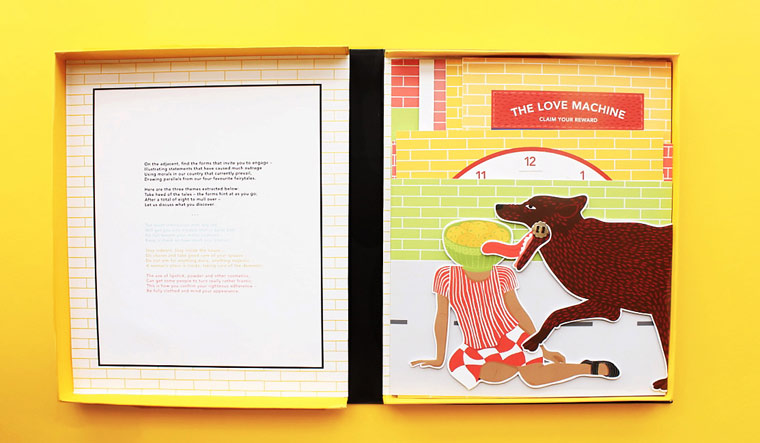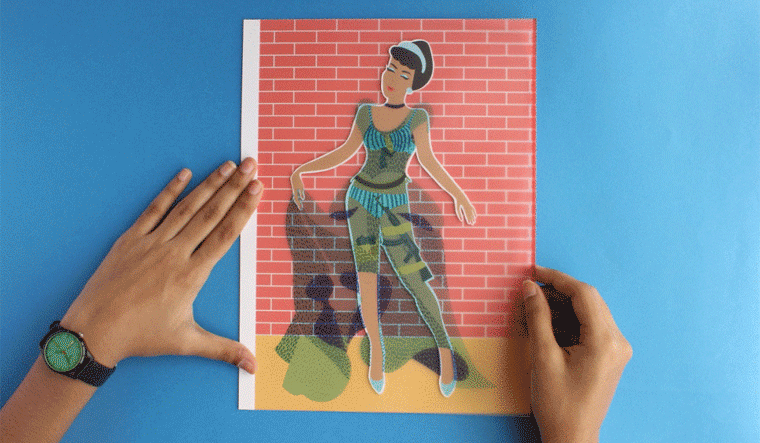Charles Perrault, who originally wrote the The Red Riding Hood in the 17th century, explicitly implied the wolf to be a man or a sexual predator. The wild beast can be of the sweet and charming variety too; perhaps the most dangerous of all wolves. In Perrault's original version of the fairy tale, the paedophile wolf gets Red to strip. She then climbs into his bed and is eaten up alive. Of course, Brothers Grimm scrubbed the grisly details in the modern version into more palatable reading for children. But what was Perrault's advice, also echoed by the famous Grimm brothers, and countless other storytellers since then? "From this story, one learns that children, especially young lasses, pretty, courteous and well-bred, do very wrong to listen to strangers, And it is not an unheard thing if the Wolf is thereby provided with his dinner," Perrault wrote.
But Mumbai-based graphic designer and illustrator Akshita Chandra doesn't believe in moralising. Especially when they are served up in fairy tales as cautionary cues. For these moral fables only serve to reinforce, normalise and perpetuate victim blaming, guilt-trips and gaslighting. In her latest project Grimm Reality, Chandra re-purposes a tightly-closing clamshell box—usually employed to safekeep dainty little books, photos and curios—into an elegant, dynamic paper art which is anti-fairy tale through and through. The book's cover declares its title, Grimm Reality, which is a poem, a plea and a manifesto of sorts.

Cinderella, conforming to her curfew, ran back home on time to validate her virtue; Snow White, taken in by the dwarfs to do house chores, was strictly instructed not to venture outdoors. Violated, Little Red only had herself to blame—being out so late alone surely brought her shame; Rapunzel shouldn’t have let down her long hair—she was banished because of her pre-marital affair.
The book art, encasing seven individual artworks, reference four fairy tales—Rapunzel, Cinderella, Snow White and The Red Riding Hood. They are then correlated to an incident or statement. For instance, Snow White was taken in by the dwarfs on the condition that she cooks, cleans, sews, make their bed and tends to other household chores when they go out to work. So, in Chandra's book, there's a bear claw arcade game which is packed with housekeeping objects. If a girl decides to play this game by inserting a coin, she only has the option to pick from sewing machines, washing utensils or plying the rolling pin.

Or how the red-hooded overcoat in Red Riding Hood was meant to ensure her safety, while also used as a symbol of her virginity. So, Chandra shutters a girl in a house with white blinds while commenting how "blinds act as a protector, something that gives us privacy and shields us from other people’s gaze. Do overcoats or 'decent' clothes really do the same?"
"The intention of the project is to comment on these notions and how they play out more like moral rules and how they become excuses to acutely judge girls for not following them and subvert the real issue—it is not the girls who are at fault, but the wolf, the assaulter, the sexual predator," says Chandra, who devised Grimm Reality as part of her undergrad thesis at Srishti Institute of Art, Design and Technology.

"The interpretation seeks to simply map out similarities I found in these morals extracted from the four tales and see how they play out in a contemporary Indian context," says Chandra.
She used the clamshell box format as interactive paper art one can "play" with to show how casual sexist statements and expectations abound. "The game-like aspect of it went well with the lens of my childhood that I was applying as part of the project," says Chandra.
This year you may want to gift your child an alternate, updated book of fairy tales with a less accusatory moral universe.



